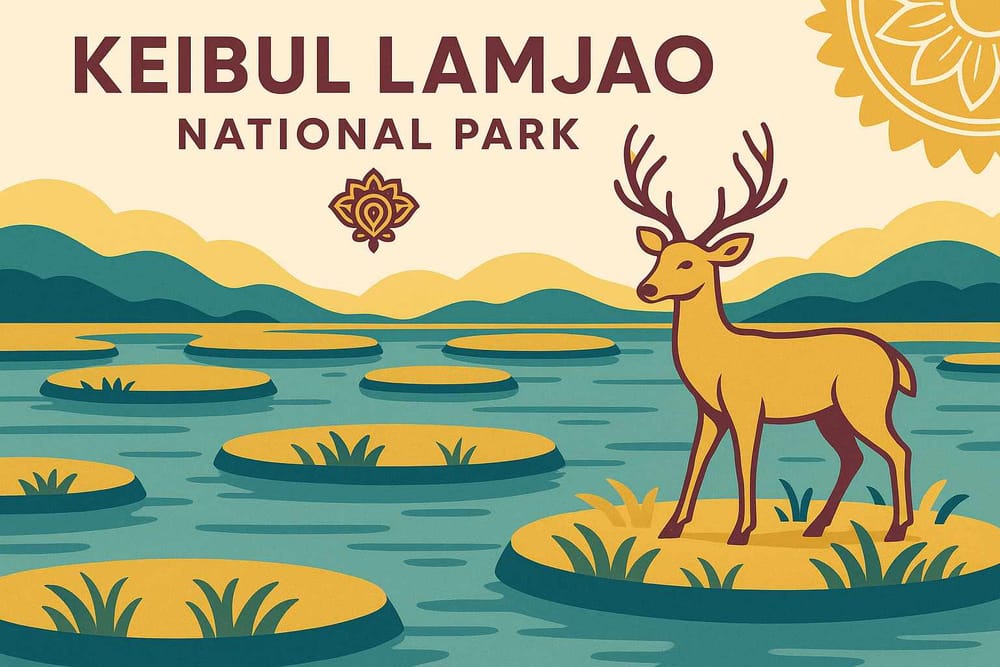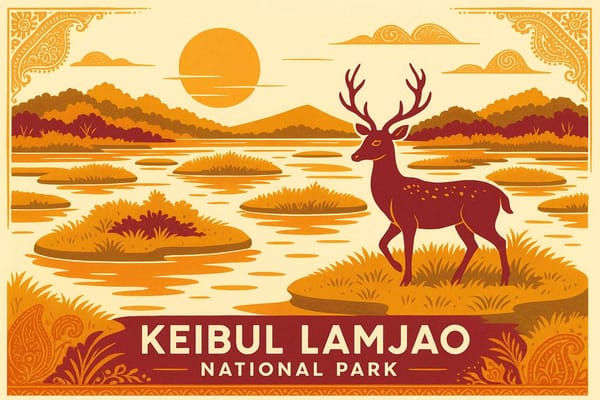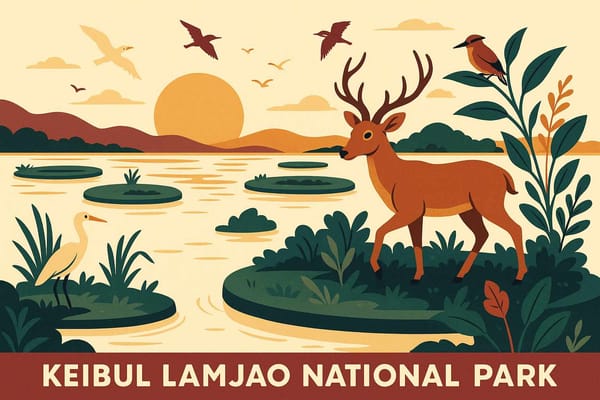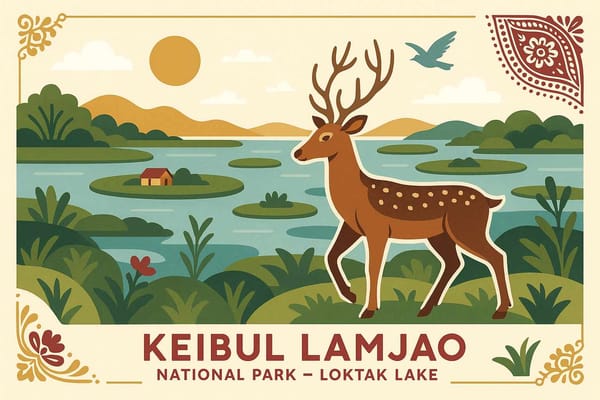
Keibul Lamjao National Park-The Only Floating Park in the World
Have you ever heard a story of a forest that floats on water? A land that isn't truly land but a beautiful, green carpet swaying gently on a lake? This isn't a fairy tale, my friend. This magical place exists right here, in the heart of Manipur. It's called the Keibul Lamjao National Park, a place so unique, so surreal, that it feels like nature’s own poetry written on the shimmering surface of Loktak Lake.
This park is not just a geographical wonder; it's a living, breathing miracle. It is celebrated across the globe as the world's only floating national park, a sanctuary that drifts and dances with the rhythm of the water. Imagine, a whole ecosystem thriving on these floating islands! It’s a sight that fills your heart with awe and makes you deeply appreciate the incredible creativity of Mother Nature.
The Sacred 'Phumdis': The Soul of the Floating Park
So, you might be wondering, what makes this park float? The secret lies in something called 'phumdis'. These are not just clumps of grass; they are intricate, naturally formed floating islands made of soil, vegetation, and decaying organic matter. These phumdis are like nature's own rafts, some so thick and large that they support a rich variety of life. They float on the surface of Loktak Lake, creating a breathtaking mosaic of green against the blue water. This unique landscape, a gift of nature, forms the very foundation of Keibul Lamjao National Park.
Loktak Lake itself is more than just a body of water for the local Meitei community; it is a sacred entity, deeply woven into their culture and traditions. Much like the spiritual aura surrounding the lakes of Udaipur, Loktak Lake holds stories and beliefs passed down through generations. The phumdis are seen as a blessing, a life-giving force that sustains the community through fishing and agriculture.
Home of the Sangai: The Graceful Dancing Deer
This floating paradise is famous for being the last natural home of a very special creature – the Sangai deer. Known as the 'Dancing Deer' of Manipur because of its delicate and graceful gait, the Sangai is the state's beloved animal. Watching a Sangai leap and prance across the springy phumdis is an experience that stays with you forever. It’s like watching a divine dance, a perfect harmony between animal and its unique habitat.
But the Sangai isn't alone. This 40-square-kilometer park is a haven for a variety of wildlife. You might catch a glimpse of hog deer, otters playing in the water, or wild boars. For bird lovers, it's a treat, especially between November and March, when many migratory birds visit this serene sanctuary.
A Legacy of Culture and Conservation
Recognizing its extraordinary ecosystem, Keibul Lamjao was declared a National Park in 1977. This was a crucial step to protect its fragile environment and, most importantly, to save the endangered Sangai from extinction. The park’s existence is a beautiful story of coexistence, highlighting the deep bond between the local people and their natural heritage.
- Cultural Heartbeat: The park and the lake are not just tourist spots; they are central to the region's folklore and spiritual life. The tales of Loktak and the mystical phumdis are a cherished part of Manipur's oral traditions, making this land a living museum of culture and nature.
- A Vital Role in Livelihoods: For the communities living around the lake, the ecosystem is everything. It provides them with food through fishing and resources for their daily lives, binding their fate with the health and well-being of the park.
At Bhaktilipi, we believe in celebrating and safeguarding such precious cultural and natural narratives. Our mission is to preserve the timeless devotional literature and stories that form the soul of our country. By bringing these treasures into the digital world, we hope to keep our heritage alive for generations to come, just as conservation efforts are working to protect the unique world of Keibul Lamjao. Explore our collection of timeless stories at Bhaktilipi.in.
Challenges and Our Shared Responsibility
Like any precious treasure, Keibul Lamjao faces its own set of challenges. The health of the phumdis is threatened by pollution, changes in water levels, and encroachment. These floating islands, the very lifeblood of the park, are shrinking. This puts the entire ecosystem, especially the Sangai deer, at risk. Protecting this park is not just the job of the government; it's a responsibility we all share to preserve this natural marvel for the future.
An Experience That Touches the Soul
A visit to Keibul Lamjao National Park is more than just a holiday. It's a journey into a world of wonder. You can take a boat ride through the narrow channels between the phumdis, watch the sunrise paint the lake in hues of gold, and feel a deep sense of peace wash over you. The best times to witness the park's magic and spot its graceful inhabitants are in the early mornings (6:00 AM - 10:00 AM) and late afternoons (3:30 PM - 6:00 PM).
This floating sanctuary, like the sacred ghats of Pushkar, offers a chance to connect with something pure and profound. It reminds us of the delicate beauty of our planet and inspires us to become better custodians of its wonders. Let the story of Keibul Lamjao echo in our hearts, a beautiful reminder of nature's resilience and our duty to protect it.
Stay Connected with Our Journey
For more stories that celebrate India's rich heritage and spiritual depth, we invite you to join our community. Subscribe to our YouTube channel, and follow us on Facebook and Instagram for your daily dose of inspiration.
A passionate group of people dedicated to preserving India's knowledge of Dharma, Karma, and Bhakti for ourselves and the world 🙏.
Comments
Related in

Keibul Lamjao-The Only Floating National Park-A 2025 Guide
Imagine a place on Earth where the land itself breathes and sways upon the water. A place where deer don't just run, they seem to dance on floating meadows. This isn't a dream or a fairytale; this is the reality of Keibul Lamjao National Park in

Keibul Lamjao National Park Biodiversity: A Unique Exploration
Imagine a land that doesn't stay still, a forest that floats upon the water like a giant, sacred lotus leaf. This isn't a fable from our grandmothers' stories; this is the living, breathing miracle of Keibul Lamjao National Park in Manipur. It's a

Keibul Lamjao National Park-Wonders Await
Have you ever imagined a place where the very land you stand on is not solid ground, but a floating carpet of green, gently swaying on the water? It sounds like something from a dream or an ancient legend, but this place is very real. It’s a jewel nestled
